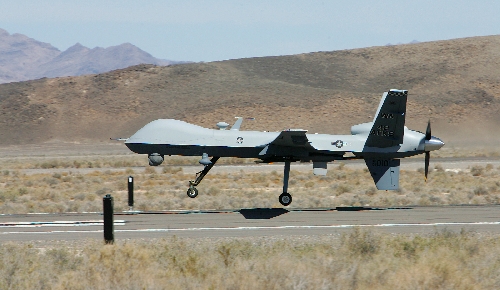Predator drone crew criticized

KABUL, Afghanistan — U.S. military investigators found that "inaccurate and unprofessional" reporting by a Nevada-based Air Force Predator drone crew was responsible for a missile strike that killed 23 Afghan civilians in February, according to a report released Saturday.
Release of the scathing report is part of a U.S. effort to counter Afghan anger over civilian deaths, which threatens to undermine the campaign against the Taliban at a critical juncture in the nearly nine-year war.
Twelve other civilians, including a woman and three children, were wounded in the strike, the report said.
Four American officers, two described as senior, received career-damaging reprimands, the U.S. command said in a statement.
The top U.S. and NATO commander in Afghanistan, Gen. Stanley McChrystal, called on the Air Force to investigate the actions of the Predator crew.
"Our most important mission here is to protect the Afghan people," said McChrystal, who apologized to Afghanistan President Hamid Karzai shortly after the attack. "Inadvertently killing or injuring civilians is heartbreaking and undermines their trust and confidence in our mission. We will do all we can to regain that trust."
The attack underscores the risks of using unmanned aircraft to fire on insurgents, not only in Afghanistan but also in Pakistan.
Drone strikes against insurgent sanctuaries in border areas of Pakistan have fueled anti-Americanism among the 175 million Pakistanis.
The deadly attack occurred Feb. 21 after the drone, controlled by a crew at Creech Air Force Base in Indian Springs, about 45 miles northwest of Las Vegas, spotted three vehicles on a main road in Uruzgan province about 7 miles from where U.S. Special Forces and Afghan soldiers were tracking insurgents.
Creech spokesman 1st Lt. Kevin Milgram said Air Force personnel is reviewing the classified report and will address its findings appropriately.
Milgram acknowledged errors were made.
"The civilian injuries and loss of life are deeply regrettable," Milgram wrote in an e-mail response to questions posed by a Review-Journal reporter Saturday. "The initial investigation report outlines discrepancies in communication, information exchange, experience levels and decision-making by ground and air assets."
Suspecting the convoy contained fighters, the ground commander ordered an airstrike, and U.S. helicopters fired missiles at the vehicles, the report said.
But the attack order was based on inaccurate information from the Predator crew and a flawed analysis of the situation by U.S. commanders, according to the author of the report, Army Maj. Gen. Timothy McHale.
Poorly functioning command posts "failed to provide the ground force commander with the evidence and analysis that the vehicles were not a hostile threat, and the inaccurate and unprofessional reporting of the Predator crew … deprived the ground force commander of vital information," McHale wrote.
"Information that the convoy was anything other than an attacking force was ignored or downplayed by the Predator crew," his report said.
After the first salvo, the helicopter crews stopped firing because they saw brightly colored clothing in the convoy, a strong indication that women were present. A video shot from the drone showed women and children present.
McHale criticized commanders for failing to report "ample evidence" of civilian casualties for nearly 12 hours after the attack while they tried for confirmation.
Rear Admiral Gregory Smith said the only people the drone operators could see in the convoy were in the back of a pickup. Smith said the Predator crew should have reported the possibility of civilians in the two cars.
"They did not report the ambiguity of what they were seeing," Smith said. "They weren’t clearly seeing a heavily armed threat."
Human rights activists welcomed the report as a sign that NATO was being more open about admitting mistakes.
"But transparency and public accountability for the conduct of troops are still the exception rather than the rule," said Erica Gaston, a lawyer who works on civilian casualties issues for the New York-based Open Society Institute.
Accidental killing of civilians by NATO forces has become a major source of friction between the Afghan government and its international partners, even though the United Nations says the overwhelming majority of civilian deaths are caused by the Taliban and their allies.
The issue has taken on new urgency as NATO prepares for a major operation to secure Kandahar, the largest city in the south and the Taliban stronghold.
NATO commanders believe securing the city is key to turning back the Taliban in the south, the major theater of the war.
But opposition to the planned operation is running high in Kandahar. That has forced NATO commanders to plan the operation carefully to minimize civilian casualties, even if that adds to the risks facing U.S. and allied forces.
Las Vegas Review-Journal writer Antonio Planas contributed to this report.